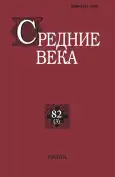BANNIARD M. VIVA VOCE: COMUNICAZIONE SCRITTA E COMUNICAZIONE ORALE NELL’OCCIDENTE LATINO DAL IV AL IX SECOLO / Edizione italiana con una Retractatio dell’autore, a cura di L. Cristante e F. Romanini, con la collaborzione di J. Gesiot e V. Veronesi. Trieste: Edizione Università di Trieste, 2020. XVIII, 716 p. (Polymnia: Studi di filologia classica; 25)
- Authors: Anikiev I.I1, Filippov I.S1
-
Affiliations:
- Lomonosov Moscow State University, Faculty of History
- Issue: Vol 82, No 3 (2021)
- Pages: 184-196
- Section: Articles
- URL: https://journals.eco-vector.com/0131-8780/article/view/630849
- DOI: https://doi.org/10.7868/S0131878021030119
- ID: 630849
Cite item
Abstract
The reviewed monograph is a translation of the French edition of 1992, revised and completed by the author in the face of scholarly achievements of subsequent years. It contains rich material on the history of the Latin language in Late Antiquity and the Early Middle Ages and on the formation on its basis of western Romance languages; yet it is not a systematic exposition of the facts which characterize this process. We are dealing with a study of one of its most important aspects, namely with the correlation of literary and spoken Latin. Analyzing very different sources (treatises, sermons, lives of saints, chronicles, acts of church councils, to a lesser extent documents and inscriptions) the author comes to the conclusion that till the end of the VIII c., in Italy – till the end of the IX c. and even later we witness the maintenance of a certain unity between the language of the educated elite and the language of the poorly educated and simply uneducated population. This unity made possible the continuity of vertical communication between the two social groups. It also helped to maintain a certain level of communication across the lands which constituted the Romance part of Europe. These conclusions are very important for evaluating the sociocultural processes of this period and the informational potential of the surviving sources as such. Having certain reservations about some of the thesis contained in the monograph, the authors of this review estimate it very highly.
About the authors
I. I Anikiev
Lomonosov Moscow State University, Faculty of History
Email: anikyev@yandex.ru
Moscow, Russian Federation
I. S Filippov
Lomonosov Moscow State University, Faculty of History
Email: isfilippov.new@gmail.com
Moscow, Russian Federation
References
- Гурычева М.С. Народная латынь. М., 1959.
- Дынников А.Н., Лопатина М.Г. Народная латынь. М., 1975.
- Филиппов И.С. Библия и средневековая правовая традиция // Электронный научно-образовательный журнал «История». 2019. T. 10, вып. 10 (84) [Электронный ресурс]. URL: https://history.jes.su/s207987840007599-7-1/ (дата обращения: 19.05.2021). doi: 10.18254/S207987840007599–7.
- Филиппов И.С. Паства и общество: кому проповедовал Цезарий Арелатский? // Universitas historiae. Сборник статей в честь П.Ю. Уварова. М., 2016. С. 185–194.
- Adams J.N. Bilingualism and the Latin Language. Cambridge, 2003.
- Banniard M. Viva voce. Communication écrite et communication orale du IVe au IXe siècle en Occident latin. P., 1992.
- Banniard M. Vox agrestis: quelques problèmes d’élocution de Cassiodore à Alcuin // Trames, 1985. Numéro special: Études Antiques: D’Hippocrate à Alcuin. P. 195–208.
- Bonnet М. Le latin de Grégoire de Tours. P., 1890.
- Bourgain P. Le latin médiéval. Turnhout, 2005.
- Closa Farres J. Aspectos y problemеs estilísticos en las homilias de S. Cesario de Arles: Tesís presentada para la obtención del Grado de Doctor a la Facoltad de Filosofía e Letras, Sección de Filología Classica de la Universidad de Barcelona, 1973.
- Fridh Å.J. Études critiques et syntaxiques sur les Variae de Cassiodore. Göteborg, 1950.
- Goelzer H. Le latin de saint Avit, évêque de Vienne (450?–526?). P., 1909.
- Herman J. Le latin vulgaire. P., 1967.
- Lot F. A quelle date a-t-on cessé de parler latin en Gaule? // Archivum Latinitatis Medii Aevi (Bulletin du Cange), 1931. T. 6. P. 97–159.
- Mohl G. Introducton à la сhronologie du Latin vulgaire. P., 1899.
- Mohrmann Ch. Études sur le latin des chrétiens. R., 1961–1977. 4 vols.
- Norberg D. A quelle époque a-t-on cessé de parler latin en Gaule? // Annales: Économies, Sociétés, Civilisations. 1966. Année 21, N 2. P. 346–356.
- Richter M. A quelle époque a-t-on cessé de parler latin en Gaule? A propos d’une question mal posée // Annales: Économies, Sociétés, Civilisations. 1983. Année 38, N 2. P. 439–448.
- Vidén G. The Roman Chancery Tradition: Studies in the Language of the Codex Theodosianus and Cassiodorus’ Variae. Göteborg, 1984.
- Wright R. Late Latin and Early Romance in Spain and Carolingian France. Liverpool, 1982.
- Wright R. [Rec. ad op.:] Banniard M. Viva voce: Communication écrite et communication orale du IVe au IXe siècle en Occident latin (Paris, 1992) // The Journal of Medieval Latin. 1993. Vol. 3. P. 78–94.
- Zimmermann O.J. The Late Latin Vocabulary of the Variae of Cassiodorus, with Special Advertence to the Technical Terminology of Administration. Washington, 1944.
Supplementary files








